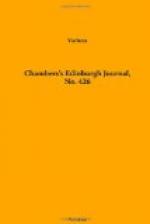Besides these lectures, a course is being delivered at the Museum of Practical Geology, recently opened in Jermyn Street, by eminent professors, as you may judge from the fact of De la Beche, Forbes, and Playfair being among them. Some of the most promising of the pupils at the School of Design are allowed to attend these lectures gratis. At the same institution, an attempt is to be made to do what has long been done in Paris—namely, to admit working-people to the best scientific lectures free of cost. Now, therefore, is the time for the working-men of the metropolis to shew whether they wish for knowledge and enlightenment or not. They have only to present themselves at the Museum, pay a registration-fee of sixpence, conform to the rules, and so qualify themselves for the course of six lectures. It is a capital opportunity; and I, for one, hope that hundreds of the intelligent working-men of London will avail themselves of it. They, on their part, may find government education not unacceptable; and government, on the other hand, encouraged by a successful experiment, may feel inclined to extend its benefits. If a clear-headed lecturer on political economy could also be appointed, perhaps in time our industrial fellow-countrymen might come to understand that strikes are always a mistake, and the masters, that fair play is a jewel.
Notwithstanding the stir about invasion and amateur rifle-clubs, other matters do get talked about—as, for instance, the astronomer-royal’s communication to the Society of Antiquaries on the place of Caesar’s landing at his invasion of Britain. The learned functionary settles it to his own satisfaction by tide-calculations: he has also been holding an interesting correspondence with a lady on the geography of Suez, as bearing on the Exodus of Scripture. And this reminds me that Dr J. Wilson has written




